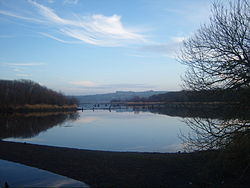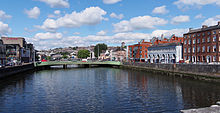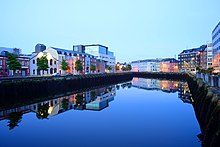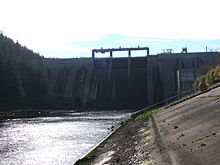
County Cork is the largest and the southernmost county of Ireland, named after the city of Cork, the state's second-largest city. It is in the province of Munster and the Southern Region. Its largest market towns are Mallow, Macroom, Midleton, and Skibbereen. As of 2022, the county had a population of 584,156, making it the third-most populous county in Ireland. Cork County Council is the local authority for the county, while Cork City Council governs the city of Cork and its environs. Notable Corkonians include Michael Collins, Jack Lynch, Mother Jones, Roy Keane, Sonia O'Sullivan, Cillian Murphy and Graham Norton.

The River Shannon is the major river on the island of Ireland, and at 360 km in length, is the longest river in the British Isles. It drains the Shannon River Basin, which has an area of 16,900 km2 (6,525 sq mi), – approximately one fifth of the area of Ireland.

The Shannon hydroelectric Scheme was a major development by the Irish Free State in the 1920s to harness the power of the River Shannon. Its product, the Ardnacrusha power plant, is a hydroelectric power station located near Ardnacrusha within County Clare approximately 2.4 kilometres (1.5 mi) from the Limerick border. It is Ireland's largest river hydroelectric scheme and is operated on a purpose built headrace connected to the River Shannon. The plant includes fish ladders so that returning fish, such as salmon, can climb the river safely past the power station.

Ballincollig is a suburban town within the administrative area of Cork city in Ireland. It is located on the western side of Cork city, beside the River Lee on the R608 road. In 2016 it was the largest town in County Cork, at which time the Ballincollig Electoral Division had a population of 18,621 people. It is located beyond the green belt from the suburbs of Bishopstown and Wilton. Historically home to the Ballincollig Royal Gunpowder Mills which is now a Regional Park, the town has seen much growth in recent years as a satellite of Cork city. In 2024, Ballincollig was named the tidiest town in Ireland.

Cork is the second largest city in Ireland, the county town of County Cork, the largest city in the province of Munster and third largest on the island of Ireland. At the 2022 census, it had a population of 224,004.
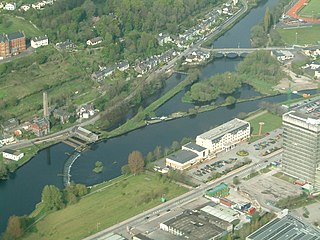
The Carrigrohane Straight is a straight segment of road that stretches for 2.75 miles (4.43 km), from the edge of Cork west to Carrigrohane in County Cork, Ireland. It is just over 140 years old, and now forms part of the N22 National Primary route between Cork and Tralee.

The Ballincollig Royal Gunpowder Mills was one of three Royal gunpowder mills that manufactured gunpowder for the British Government. Located in Ballincollig, Cork city, Ireland, largely in what is now the Ballincollig Regional Park, the powder mills were originally opened in 1794 as a private enterprise, before being taken over by the British Government during the Napoleonic Wars.

Dripsey is a village in County Cork on the R618 regional road around 20 km (12 mi) west of Cork City. It is situated on a tributary of the River Lee, the Dripsey River. It is in the Catholic parish of Inniscarra. The Dripsey area hosts a water treatment plant, the Cork offices of the Environmental Protection Agency, and an award-winning garden center. The village has one pub, a primary school and a pre-school.
Canovee is a rural region, with a village nucleus, in the Lee valley in County Cork, Ireland. The toponym 'Canovee' is synonymous with the official version 'Cannaway', and the electoral division of Cannaway.
Muskerry GAA is a Gaelic football and hurling division located in the middle region of County Cork, Ireland. It is one of eight divisions of Cork GAA County Board. The division includes clubs from areas to the west of Cork city stretching to the county bounds with Kerry. Its name is derived from the ancient Gaelic kingdom of Múscraige which, following the Norman conquest, now encompasses the baronies of Muskerry West and Muskerry East. These baronies, or half-baronies, include towns such as Macroom, Ballincollig, and Ballingeary. Muskerry GAA is bordered by Carrigdhoun GAA and Carbery GAA divisions to the south and by Duhallow GAA to the north. It organizes competitions for the clubs within the division, from "Under 12" up to the adult level. The winners of these competitions compete against other divisional champions to determine which club is the county champion. In addition, the division selects football and hurling teams from the adult teams playing at junior level or county intermediate level; these then compete for the Cork Senior Football Championship and Cork Senior Hurling Championship.

Inniscarra is a civil parish in the barony of Muskerry East, County Cork, Ireland. It is located about 15km west of Cork city. The local GAA club is Inniscarra GAA and Dripsey GAA. Inniscarra is located on the north side of the River Lee. Inniscarra Dam is one of the two Hydro-Electric Dams on the River Lee.

Inniscarra Dam is a buttress dam located on the River Lee in the civil parish of Inniscarra in County Cork, Ireland. Construction of the dam started in February 1953 and resulted in the formation of the Inniscarra Reservoir. The dam is owned and operated by the ESB Group and has a generation capacity of 19 MW. It over-flooded in November 2009 and caused around 100 million euros worth of damage to the city, with University College Cork saying it damaged 20 million euros worth of property.
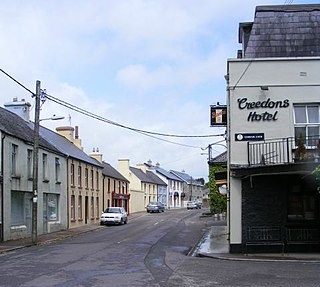
Inchigeelagh is a small village, townland and civil parish in County Cork, Ireland. The village is just outside a Gaeltacht area. Inchigeelagh is part of the Dáil constituency of Cork North-West.

Lough Allua is a freshwater lake in County Cork with an area of 1.36 km² located beside Inchigeelagh and forms part of the River Lee.

Inniscarra Lake is located along the River Lee in County Cork, Ireland. It is a man-made reservoir formed in the 1950s when Inniscarra Dam was constructed by the Electricity Supply Board. Construction of the dam commenced in 1953, with its floodgates first closed in 1956 and the reservoir fully formed by late 1957.

The Gearagh is a submerged glacial woodland and nature reserve two kilometres southwest of Macroom, County Cork, in Kilmichael parish, Ireland. It is located at the point where the River Lee descends from the mountains and widens at an alluvial plain, and stretches for roughly five kilometres, bounded by the townlands of Toonsbridge, Illaunmore and Anahala.

The R584 road is a regional road in west County Cork, Ireland.

Carrigadrohid hydroelectric power station is a hydroelectric plant located on the River Lee in County Cork, Ireland. It is owned and operated by the ESB Group. The dam is 130 m (427 ft) long and has a single 8 MW (11,000 hp) Kaplan turbine which produces an average of 22 GWh (79 TJ) each year. Built between 1952 and 1957. the construction of Carrigadrohid required the destruction of over half of the Gearagh, an ancient alluvial forest, and initially harmed local wildlife. However, subsequently the area has seen the growth of an ecosystem with kingfishers, otters, salmon and swans, which has been designated European Union Special Area of Conservation.

The Curraheen River is a river in County Cork and Cork City, Ireland, a tributary of the River Lee.

Ballincollig Regional Park is a park in Ballincollig, County Cork, Ireland, created on the grounds of the former Ballincollig Royal Gunpowder Mills.
